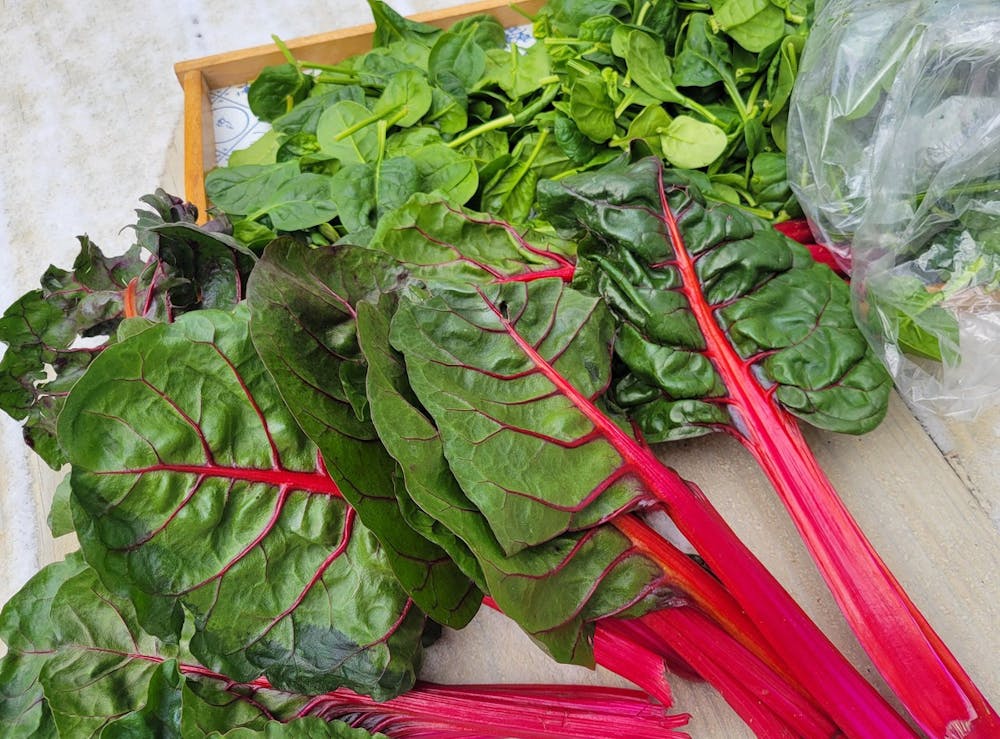Leafy greens, including spinach, Swiss chard and kale, are the principal local vegetables available this time of year at Oxford’s Farmers Market. Our local farmers have figured out how to grow leafy greens indoors when it is still too cold to plant outside.

Kristi Hutchinson holding spinach grown at Five Oaks Farm and sold at the Oxford Farmers Market.
I like to look up the history and geography of our local produce. Spinach and chard have similar stories. Both were domesticated in Asia, carried to Europe by traders and brought across the Atlantic Ocean by European settlers. Precise dates and responsible individuals are unknown.
I expected to find a similar story about kale, but I was wrong. We know kale’s precise arrival in the United States. It was brought to the United States from present-day Croatia in 1900 by David Fairchild, who was known as the Food Spy.
At the age of 22, Fairchild was hired to form the Section of Foreign Seed and Plant Introduction in the U.S. Department of Agriculture. For the next several decades, Fairchild traveled around the world in search of plants, cuttings, seeds and ready-to-eat fruits and vegetables that he considered suitable for growing and consuming in the United States.
Fairchild was responsible for introducing more than 200,000 plant species into the United States during the 1890s and first decade of the twentieth century, ranging from avocado to zucchini.
Fairchild was known as the Food Spy because he sometimes resorted to theft and undercover work. For example, he stole lemons that he found growing in Corsica and smuggled them out of the island in his pockets. America’s beer industry is built on hops that Fairchild snuck out one night from a well-guarded field in Germany.
Because of Fairchild, Americans grow and consume cashews, pistachios, quinoa, soybeans and dozens of other foods – not to mention beer. He is credited with having a greater impact than any other individual on what American farmers grow and what Americans consume. He was also responsible for bringing the cherry blossom trees from Japan to Washington, D.C.
At the Farmers Market, the freshly-picked leafy greens are sold in plastic bags. Make sure to buy enough, because a big bag of greens cooks down to only two portions. The reason is that leafy greens are composed mostly of water: 86%of kale, 91% of spinach and 93% of chard.

Jessica Bayne holding Swiss chard grown at 7 Wonders Farm and sold at the Oxford Farmers Market.
To prepare fresh chard and kale for cooking, tear the leaves off the pithy stalks. Spinach doesn’t require this step. If the stalks look good, don’t discard them. Chop them up and throw them into a stir-fry.
Enjoy what you're reading?
Signup for our newsletter
Don’t cook the greens in a pot of boiling water. The cooked greens will emerge waterlogged, and most of the nutrients will leach into the water.
The best way to cook leafy greens is in a large skillet. Gently heat a small amount of olive oil and add the leaves a few at a time. Keep adding more leaves until the quantity is sufficient for your meal. Cover the pan and reduce the heat to simmer.
March is a month for showing the “green.” Serving a leafy green like spinach, chard and kale is a healthy and locally-sourced way to display that color.
Jim Rubenstein is Professor Emeritus of Geography. At Miami, he was Chair of the Department of Geography and Adviser for the Urban & Regional Planning major. He now writes human geography textbooks and consults on the auto industry at the Federal Reserve Bank of Chicago. In Oxford, he is Treasurer of the Board of Directors of MOON Co-op Market.




